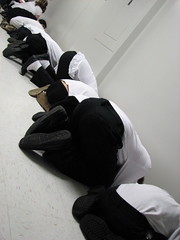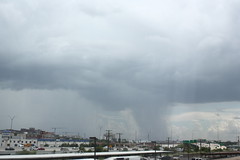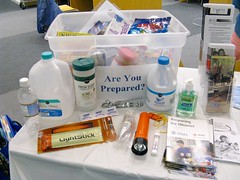How to: Protect yourself in severe weather
Following a series of severe storms that tracked across the southern U.S. earlier this week, many of the comments on my Twitter feed by friends affected by the weather led me to a somewhat surprising realization: many people living in areas where severe weather is common aren’t really sure what actions are necessary or they aren’t sure which actions are best to take in their specific situation. In this post, I will discuss several basic things about severe weather (specifically spring and summer thunderstorms), how to prepare, and how to react. Most of the advice I give will be fairly general, so it can be adapted to most situations. However, I will touch specifically on the subject of tornadoes in urban areas and how to take shelter in upper-floor dwellings, as these are topics of particular interest to many of my readers.
Watch versus warning
One of the most common confusions about severe weather that I see is the difference between a watch and a warning. Whether the severe weather in question is a severe thunderstorm or a tornado, the meanings of “watch” and “warning” are pretty much the same. (For other weather conditions such as hurricanes and blizzards, they take on slightly different meanings, but in all cases, a warning is more serious than a watch.)
A watch means that conditions are favorable for severe weather to develop. This does not mean that severe weather will develop but rather it usually means one of two things:
- That current weather conditions are such that there is an elevated probability that severe weather will develop somewhere in the watch area during the watch period.
- There is a storm system associated with a cold front (or similar predictable weather system) that has a history of generating severe weather and that is predicted to move through the watch area at some point during the watch period.
The reason that this is a watch instead of a warning is because the predictions are often several hours out from any severe weather actually occurring in the area, and meteorologists cannot predict more precisely where the severe weather will be or even if any storm system will continue to produce severe weather when it reaches your area.
In the event of a watch: Don’t panic. It might not even rain. Go about your life as usual (but maybe pack an umbrella). Keep an eye on local weather conditions throughout the day via local radio or TV, the Weather Channel or the internet for further developments.
A warning means that severe weather is happening in your area or is moving quickly into your area. Warnings are reported generally as affecting whole counties (or parishes if you live in Louisiana), but in reality, warnings usually only apply to certain parts of a county, and can be pretty specific down to a handful of neighborhoods. If a warning is issued for your county, check with local media or online to see which parts of your county are specifically affected to know whether or not you are in any danger. Severe thunderstorms typically have heavy rain, high winds, frequent lightning and possibly some hail. Depending on conditions, severe thunderstorms can produce tornadoes. A tornado warning will supersede a severe thunderstorm warning if a storm shows indications of tornado activity.
In the event of a warning: You will experience severe weather soon if you are not already. If you have time before the storm arrives, secure outdoor items such as lawn furniture or anything else that may blow away in high winds or be damaged by hail. Seek shelter as appropriate (see below) and stay tuned to a local weather outlet (TV or radio) for updates.
A quick word about risk evaluation
To paraphrase my economics professor in grad school, humans are terrible evaluators of risk. They tend to prepare and worry for the unlikely while ignoring risks that are much more likely. The more often you and those around you are faced with a risky situation and escape unscathed, the less likely you are to see that situation as at all concerning. But if that situation is foreign to you, it is more likely you will overestimate the risk. There are two common examples of this:
- Many people are more worried about dying in a plane crash than in a car crash, even though the latter is much more likely.
- People who live someplace (or grew up in a place) where tornadoes are common are often not bothered at all by severe weather, and often will go outside to take pictures of the storm instead of seeking shelter. (I will admit, I am guilty of this.) This is in contrast to someone who lives someplace where severe weather is uncommon, who is likely to panic at the suggestion that a tornado could develop somewhere even remotely close by.
All of the reactions in those examples are good illustrations of poor risk evaluation. It is important to take time to carefully consider the risks of severe weather. To put things in perspective, by the numbers, it is almost 10 times more likely that you will die from a firearm assault than from any natural disaster or weather event. The likelihood of death specifically from a tornado or lightning strike are each less than even the likelihood of dying in an air travel accident or even dying by legal execution!
Generally, a severe thunderstorm poses a low to moderate risk to most people, but can result in some high-risk situations, usually not involving human life, but rather involving property damage, minor inconvenience or financial loss, or minor bodily injury. Below, I have outlined how to mitigate these risks without over- or under-reacting.
Shelter and safety in a severe thunderstorm
During a typical severe thunderstorm (one that does not produce tornadoes), the safest place to be is indoors. The next safest place to be is in a vehicle. During most storms, it is perfectly safe to remain on upper floors of buildings and continue your activities indoors as usual, with some precautions.
It is generally not advisable to use landline telephones during a thunderstorm. This also applies to the use of dial-up internet. (Fun fact: I actually fried a modem this way many years ago.) There is some debate over the safety of mobile phone use during storms, but the risk posed by electric shock or power surge over telephone lines is only a concern with landline phones.
Sensitive electronics such as TVs, computers, DVRs, video game consoles, or similar that are not plugged into surge protectors should be unplugged in order to prevent damage. Some experts advise unplugging all electronic devices whether or not they are surge-protected, but with as many electronics that are in a typical household, this is often not practical in areas where three or four storms a week are not uncommon during summer months. I personally recommend putting as many of your electronics as possible on surge protectors or UPS (battery backup) devices just as a good practice.
If you are driving, you may continue to do so at a reduced speed with your low-beam headlights on (this is the law in many states but in general it’s just a good idea), but if you do not feel safe continuing because of wind or low visibility, turn on your hazard lights, pull over, stop, and wait for the storm to pass.
Shelter and safety in a tornado
The following advice can also be applicable during a thunderstorm with very high winds, as many of the hazards are the same. If a tornado warning is issued for your area, secure loose outdoor items if you have time, but otherwise, seek shelter immediately. Unlike in a thunderstorm, vehicles are not adequate shelter in a tornado. Mobile homes and other temporary structures are also not safe during a tornado. If you live in a mobile home or similar structure without an attached foundation, it is important to have a plan in place for shelter far ahead of any possible severe weather.

Look familiar? In the event of a tornado, especially if your shelter area is not ideal, you should assume this posture either with your feet toward the major source of potential debris or your head toward an interior wall, whichever is more feasible. Credit: lyricsart on Flickr
In general, in the event of a tornado, you should seek shelter in a basement, cellar, storm shelter or an interior, windowless room or hallway on the lowest floor of your home. If you live in a multi-story apartment building, and you don’t live on the ground floor, you can either shelter in place in an interior, windowless room or hallway, or in advance of any severe weather, you can make arrangements with an occupant of a unit on the ground floor.
Other than a basement, the safest place in most structures during a tornado is a room, hallway or closet that does share any walls with the exterior of the building and does not have any windows. Bathrooms often fit this description, and are considered ideal because they are effectively reinforced with pipes.
If no place in your home fits all of these criteria, it is probably better to opt for a windowless room that touches an outside wall than an interior area that is more exposed to windows, as there is a greater risk for injury that comes from flying debris and broken windows than there is a risk that the tornado is going to take out your entire house. If no place in your home is completely sheltered from potential broken windows, position yourself the best you can away from them and assume the position that you likely learned during school tornado drills: tuck your legs under your body with your feet facing the potential danger for flying debris; put your head down against the wall, and cover the back of your neck and head with your hands. You may also cover yourself with a blanket or jacket to further protect yourself from any possible flying debris.
If you are in a vehicle and a tornado warning is issued for your area, driving to the nearest appropriate structure is ideal. Pretty much any public building will do, but if you’re in a populated area and you have the luxury of time or a choice, the fewer windows it has, the better. If you’re actually confronted with a tornado while driving, most experts recommend turning around and driving toward brighter skies as immediately as is safe. You should then attempt to find shelter. The oft-repeated recommendation of leaving your vehicle and sheltering in a ditch or similar low area should only be done as a last resort.
Tornadoes in urban areas
Because the majority of my readers live in urban areas, I want to specifically address the subject of tornadogenesis in cities. Generally speaking, tornadoes do not usually form in dense urban areas because several characteristics of cities tend to disrupt storms in general. However, as residents of both Atlanta and Fort Worth (as well as other cities where I don’t have as many readers) have seen in recent years, it is possible. Urban tornadoes are not typically very strong tornadoes (relatively speaking, though they tend to do as much damage as stronger tornadoes because of the dense development), nor are they typical in appearance or behavior.
Instead of the expected funnel cloud and “freight train” sound, urban tornadoes are often not even recognized as being tornadoes at all until after the fact. Conditions during these storms are similar to a severe thunderstorm with very strong winds but tend to pick up more debris and cause more wind-related damage such as torn-off roofs and blown out windows. Urban tornadoes do not tend to travel as far as most tornadoes and tend to dissipate more quickly.
So, even if you live in an urban area, it is advisable to, at a minimum, have a shelter plan in place in case of an approaching storm with a history of high winds or tornadic activity.
Preparing ahead of time
Nearly all regions of the United States are at some risk for seasonal severe weather, though some regions, such as the Midwest and the South, are at higher risk than others. It is likely that if you live someplace that is at a higher risk for severe weather, you are aware of that risk. Well ahead of severe weather season, there are some minimum preparations that everyone should make.
First and foremost, every home should have a first aid kit. Regardless of any threat from severe weather, this is just a good idea. Secondly, make sure that everyone in your household knows where to take shelter in the event of severe weather. It is also a good idea to know where to go if you are at work, school, or some other place you go frequently. This often means asking questions if you don’t know, making arrangements with neighbors if your home is not adequate shelter during a storm, or making your own evaluation of the safest place to go. Somewhat related to this, I mentioned earlier that in the event of a severe weather warning, you should ensure that any outdoor furniture or other items are secure if you have time to do so. It is very likely that you will not have time, so it is a good idea to keep the area around your home free of anything that could easily become a projectile in high winds by keeping your yard picked up and by tying down or otherwise anchoring outdoor furniture to the ground, porch or house in a more permanent manner. (Additionally, this precaution can also help prevent theft in areas where this may be a problem.)
It is also generally a good idea to keep important paperwork and documents (or at least copies of them) such as birth certificates, passports, other identification, financial documents, wills, etc. in a single, central, safe, and quickly-accessible place. Additionally, each room in your house should have a working flashlight in it in case of a power outage, and you should have at least one battery or crank-powered radio or TV in your home. You should also keep an extra store of batteries for the flashlights and radio, if necessary. In general, it is also a good idea to keep a small store of drinking water and non-perishable, ready-to-eat food in your home. Usually, storing it in your pantry is sufficient, however there are some circumstances that I discuss below where storing it elsewhere may be advisable.
Most experts recommend making emergency kits containing three days’ worth of drinking water and non-perishable food (among other things) for each member of your household. Comprehensive emergency kits are generally recommended for people living in earthquake risk areas, hurricane evacuation zones, and other areas where extended utility and service outages or shortages may be common following a storm or other event.
FEMA provides a very comprehensive checklist for a disaster kit that is probably a bit much for the circumstances of most people. Ready.gov’s checklist for an emergency kit is more moderate and practical for most households. Some sources recommend keeping all of these items together in a container for each person in your household so you can pick them up and leave with them on short notice. However, this is not practical for most people, and is really only necessary if you may be evacuated on very short notice. What you keep together and what you keep separate is something that depends largely on the judgement of the individual and what you feel you need.
Summary
Severe weather is simultaneously cool and scary, and it certainly poses some risks, though the risks might not be what you expect. However, with proper preparation and positive action, it is possible to know and minimize those risks. I have tried to be as thorough as possible in describing the most common actions and best practices for severe weather preparedness. If I have missed something, gotten something horribly wrong, or if you have any questions, feel free to leave a comment.
I am not a meteorologist or a public safety worker, but I am quite a meteorology enthusiast and have been since I was very young. I have largely refrained from getting too technical about any of the weather topics I’ve discussed, but I would be happy to write more at length about them if anyone is interested.





1 Response
[…] and hurricanes to severe electrical storms to herds of steers, Texas has had its fair share of severe weather. Do you know what to do in case of a severe storm? Do you know how to prepare? Here are a few tips […]